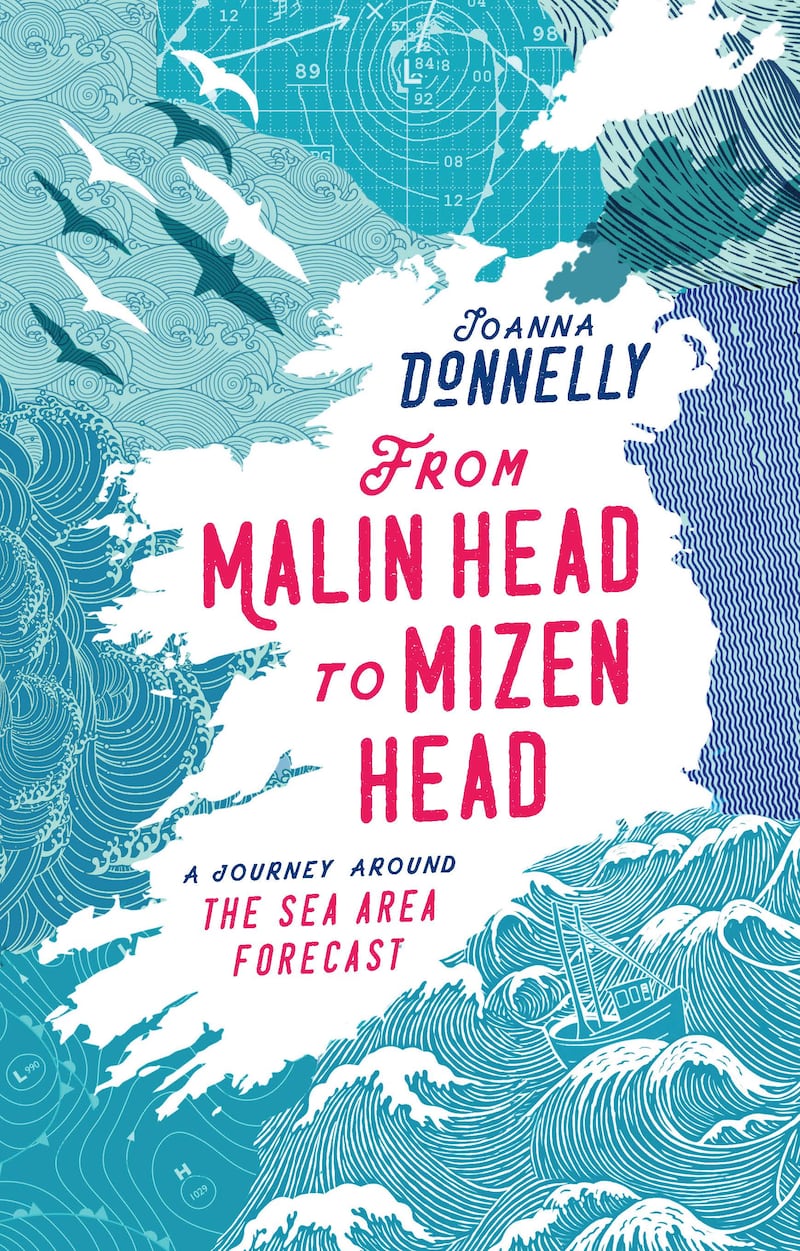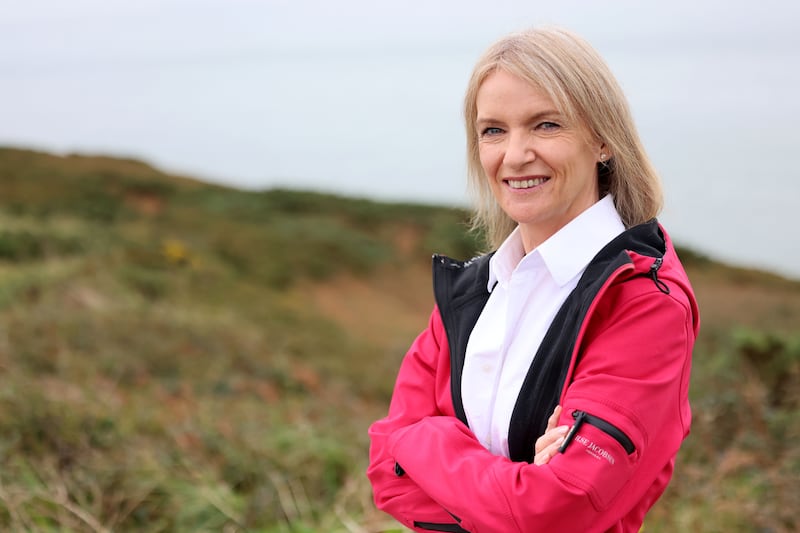For a small and dedicated cohort of the population, the sea area forecast is the first thing they hear in the morning (at 6am) or the last thing they hear at night (11.57pm, RTÉ Radio 1).
The forecast is a reminder that we are an island surrounded by seas that beat ceaselessly on our shores. Belmullet, northwest, 23 knots, cloudy, 998, falling slowly. What does it all mean? Where is Rossan Point? Why is Bloody Foreland so named? Why are there exotic sub-tropical ferns in Valentia?
Grief and curiosity brought meteorologist Joanna Donnelly around the headlands of Ireland’s sea area forecast, names that are so well-known but places that are seldom visited – being by definition the furthest extremities on this island.
In September 2021, her mother Marie Kelly went for a routine eye operation. She was a healthy 77, but died suddenly, much to the shock and grief of her family. From Malin Head to Mizen Head: A Journey Around the Sea Area Forecast is dedicated to her. “Her sudden departure from this world set me adrift. The journey around the headlands has helped me to start to right the course,” Donnelly writes.
READ MORE
As the first anniversary of her mother’s death approached, she felt a build-up of stress and tension remembering the last time she did things with her. “I was panicking because I wasn’t getting any better.”
She got into her car and drove to Loop Head in Co Clare, a journey of 350km, the furthest she could drive and return to Dublin in the same day. It was a coping mechanism she used as a younger woman. “It’s a great release and freedom to leave your problems far away.”
As she left Dublin before 7am, it was lashing rain, but she knew when she crossed the Shannon that the sun would come out – one of the perks of the job.
“It was one of the most successful days of my life. It was going over the rainbow into another dimension,” she recalled. “It was like a week’s holiday in a day, and then I came home.”

Loop Head, she recalled, was “spectacular, awesome”, with its 17th century lighthouse that affords views as far away as the mountains in Kerry and out to the vastness of the Atlantic. If this headland look like this, what do the others look like?
At the time she was reading Charlie Connelly’s Attention All Shipping, A Journey Round the Shipping Forecast, a book published in 2005 in which the author and comedian, a Londoner with Irish roots, visited all the areas mentioned in the shipping forecast. Viking, North Utsire, South Utsire, Fisher, Dogger, German Bight, the names are familiar to late-night listeners of BBC Radio 4 even if many could not point to these places on a map.
They knew enough though to protest bitterly when the name of Finistere (world’s end) off the north coast of Spain was changed in 2002 to the rather more prosaic Fitzroy after the founder of the UK Met Office. People have an emotional attachment to sea area forecasts.
Donnelly travelled clockwise around the headlands of Ireland from Loop Head to Slyne Head to Erris Head, from Bloody Foreland to Malin Head to Fair Head, all the way around the coast to Valentia Island in Co Kerry.
She has recited the names late at night herself on many occasions, speaking slowly for those who might be listening at sea and those tucked up in bed. “As an insomniac myself, I know how important it is to put people to sleep,” she says.
The book is as much a meditation on the weather as it on Ireland’s headlands. There are diversions into how a tragedy in the Irish Sea, the sinking of the Royal Charter in a storm in 1859, led to the first co-ordinated weather forecast. There are asides on major weather events, most notably Storm Ophelia in 2017 and Storm Emma in 2018, which dumped “buckets of snow” on Ireland, as Donnelly told The Irish Times at the time. Communicating science in a clear way is a big priority for her. Her first title, The Great Irish Weather Book, published in 2018, was aimed at children.
I never assume people know me, especially young people. Some of my biggest fans are octogenarians. Old people know me
She’s an accidental meteorologist, having studied applied mathematics in DCU. Her final-year thesis was a mathematical analysis of air pollution, as measured off Mace Head. While studying the data at Met Éireann, she knew this was what she wanted to do.
She qualified as a meteorologist in 1995. She met her husband, Harm Luijkx, who is Dutch, when they were both studying in the UK in 2001. His name is not on the cover, but he is mentioned as a co-author inside. What do two meteorologists, who are married to each other, do for small talk when they can’t talk about the weather?
“We used to put Nicci our daughter to sleep talking about the weather. She was sitting in the back in of the car once and she asked my mother, ‘What’s a nerd?’ And my mother said back to her, ‘Your mammy and your daddy’. He’s an even bigger nerd than me.
“We love the weather. We give out about the bureaucracy, but we love our jobs and the science. I couldn’t be the meteorologist I am without having Harm as my right-hand man. We complement each other a lot.”
Luijkx was a regular fixture on RTÉ Radio when he was with Met Éireann, where he started in 2005. Now he works as a meteorologist for the Irish Aviation Authority (IAA).
Donnelly did not begin to present the weather on RTÉ until 2016. There are six rostered Met Éireann meteorologists for the television news slots at 6pm and 9pm. In 1999, RTÉ attempted to get rid of professional meteorologists as presenters. They were eventually reinstated following a public outcry.
“If you want to be on TV, be on TV; if you want to be a meteorologist be a meteorologist. Don’t be a meteorologist to be on TV,” she says.
In our weather-obsessed countries, presenters become public property.

“I never assume people know me, especially young people. Some of my biggest fans are octogenarians. Old people know me.”
In Ireland we have weather, four seasons in one day, other places have climate.
People ask Donnelly all the time for a forecast. The film director John Carney asked her to give him a forecast for his wedding, as he was thinking of erecting a marquee, she says. People want to talk about the weather all the time.
While on Howth Hill for a photograph, a man who had come to cut the gorse pretended never to have heard of Malin Head, nor to recognise her. When he admitted he’s pulling her leg, he then informed her the idea July was the wettest in recorded history in Dublin (which it was) was not true, because the Hill of Howth got hardly any rain. Donnelly explained the Hill of Howth (which is in the sea area forecast) has its own micro-climate. The south side gets most of the rain, and the north side is drier being on the leeward side of the hill.
A similar microclimate can be observed on the windward side of Valentia Island in Co Kerry, where sub-tropical ferns as tall as houses grow and rhododendrons were blooming in December. The weather never ceases to surprise.
“All humans start their conservations with the weather because we are at its mercy,” she says. “People ask me how long the book took to write. I say 25 years. That’s as long as it takes to learn how to tell this story.”
From Malin Head to Mizen Head: A Journey Around the Sea Area Forecast, by Joanna Donnelly, is published by Gill Books

















